It’s with sadness that we note the end to an end. The French dance music duo Daft Punk have split up, announced in a video that’s has already clocked 22 million views.The band have inspired hardware geeks across the world not just with their music but the way they present themselves. A perennial project has been to replicate in some way their iconic robot helmets.
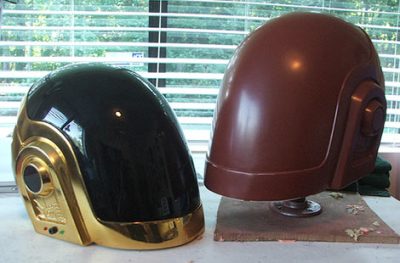
The artists themselves have been reticent about the exact technology that powers their headgear, but while this is a source of endless mystery and speculation to the music press it’s safe to assume from our perspective that their designers have the same parts at their disposal as we have. Microcontrollers, EL wire, and LEDs are universal, so the challenge lies in artistic expression with the helmet design rather than in making the effects themselves. We’ve reached into the archives for a bit of Daft Punk helmet nostalgia, so stick on Harder Better Faster and lets take a look at them, er, one more time.
One of the earliest Daft Punk helmets we featured came from Ben Heck Harrison Krix, a very high quality sculpted Guy-Manuel de Homem-Christo model replicated as a resin shell by means of a flexible silicone mould, and given a vacuum-formed visor.
Harrison used very similar techniques to make the helmet itself, but knocked it out of the park with the LED lighting effects to bring the life the closest helmet you could have to a real one without being in the band itself. Not content with just one, he returned a year later with his version of Thomas Bangalter’s headgear.
Advancing Tech Just Makes Them Better And Better
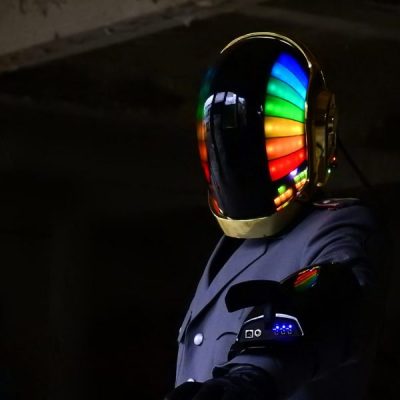
In 2014 Adafruit published a design for a 3D printed Guy-Manuel helmet, which would have paired nicely with Marc’s Thomas helmet whose shell was printed in polycarbonate on a high-quality industrial printer. This one featured iPhone control, and marked a trend of the helmets increasing in technical capabilities as the decade progressed and better components became available. Mike Michelena’s Guy-Manuel helmet from 2016 reached a new height both in physical and technical sophistication with a huge array of features including MIDI control.
Each of the helmets presents its own design challenges, and the Thomas helmet in particular requires an LED array to an exacting specification in a curved plane. This is no easy task to get right and requires some fine soldering skills with a huge pile of discrete LEDs. Nathaniel Stepp showed us how it should be done in the fall of 2018 with some particularly fine workmanship. For mere mortals the job could be done with LED strips, as ElectroNoobs’s much simpler build showed us.
As it has with so many things, the pandemic seems to have claimed everybody’s attention and last year must have pushed partying away from the limelight. Estefannie’s Guy-Manuel helmet was the subject of a talk at the 2019 Superconference, and since then the scene has been quiet. But that’s not quite the end of the story though, because there’s a parallel stream of other helmets that aren’t replicas but maybe owe some inspiration to the French duo. Mocymo’s Smile helmet for example uses an Android tablet for its display and electronics,and ingeniously has a built-in periscope to see past it.
Daft Punk themselves may have disbanded, but that doesn’t mean the story should be over in our community. It’s likely that the time period following the eventual all-clear from this virus will be marked by an outpouring of excess from the party-starved and newly-vaccinated masses, so if you’re a fan then perhaps now is the time to start building.

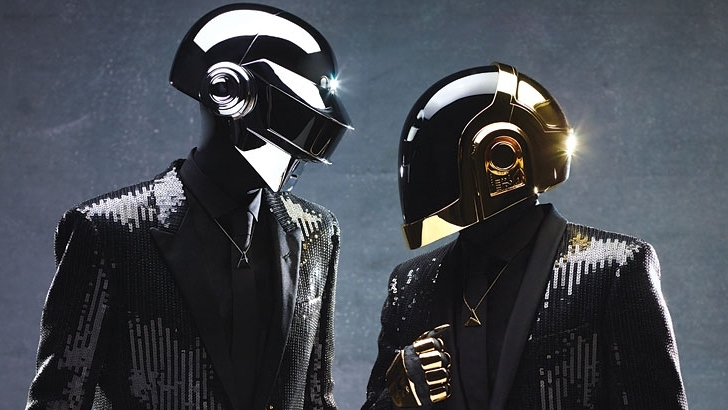
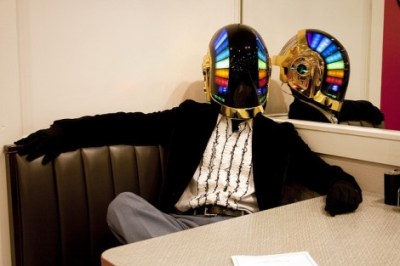
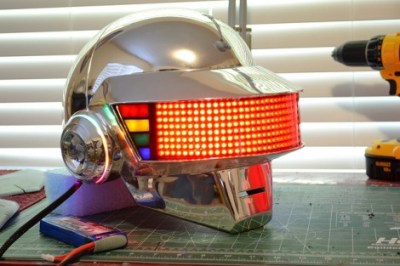















Eleven years ago… long before 3D printers… “Harder, Better, Faster, Stronger” inspired me to build Daft Punk Pandas!
Great memories. Thank you Daft Punk!
https://www.youtube.com/watch?v=gQuQ93SBeRg&ab_channel=HariWiguna
Thank you for this.
That’s criminally underrated, and totally in the spirit of Daft Punk. Nice job.
Oddly satisfying. I died when they start looking at each other. Great work on this!
What a waste of a pun !
You should have spelled it “The band have inspired hardware geeks AROUND the world” ^_^
And to be grammatically correct, it should say “The band HAS inspired hardware geeks AROUND the world”, but hey, we’re all techs here and not authors nor novelists, right?
Great article BTW.
I’m an English teacher by day. Hackers & makers don’t always fit into single label boxes.
The grammar of that sentence depends on your country of origin. American residents would consider a band to be a single thing. A UK resident might see it as a collective thing.
Interesting. Cambridge agrees. In British English, a collective noun in singular can be followed by a singular or plural verb: “the band plays” or “the band play.”
Just goes to show you there’s almost always someone smarter than you on a given subject at HaD.
I used to be pedantic/stubborn about things like “they” being only used as a plural third person pronoun and not as a singular, but I’ve come to accept that language changes, and that’s ok.
Hackers and makers don’t need proper English, they just need to make things go brrrrr.
The 2009’s helmet was NOT made by Ben Heck, he was only cited on the post for his fabrication skills; it was made by Harrison Krix, from Volpin Props.
the cite was indeed confusing and unnecessary, the namedrop unhelpful.
‘duo’ is more realistic than ‘band’ mentioned; disbandment is what happened before the duo.
They are some seriously cool designs
https://youtu.be/-1TB4E4oY1I
Check this one out!
Tribute to Daft Punk👇
https://youtu.be/-1TB4E4oY1I
” it’s safe to assume from our perspective that their designers have the same parts at their disposal as we have.”
Is it? I mean, sure. They do. Now. But they started in 1993! They predate the Arduino, the explosion of addressable RGB LEDs and cheap parts available on the internet. Maybe their latest creations look just like any hackerspace workbench on the inside. Or maybe not. But the older ones must have been different.
The didn’t adopt the masks here until much later. There are 1990s pics of them with bin bags and carnival masks.
I read in the Wikipedia that they started using the helmets in 1999 (during the “Discovery” album). In that time, the PIC16F84 was well known, it is a very easy-to-use microcontroller (it can work without external quartz, and can be programmed using a serial port). In fact, I used it a lot in that era. So yes, Arduino didn’t exist, but there were a lot of alternatives quite equivalent.
I was one of the builders if the original Discovery helmet. It was a bit of a nightmare as each of the LEDs was independently wired to a backpack unit. There were actual controls on their forearms for preprogrammed sequences. Visibility was near none, and they were heavy. The wiring harnesses alone were near 1 1/2″ in diameter and it was difficult for Guy Manuel to turn his head . We used LED sign software to run them through an off the shelf board. I had to show Tomas how to operate the software, he was quick on this stuff. We did a photo shoot in the hollywood hills while they played the yet to be released Discovery album. It’s a fond memory and amazing to have been a part of.
You do know that now that you have dropped that bombshell you’re gonna have to write up an article on it as people are gonna want to replicate them as originally made
FULLY AGREE!!!!! We want data!!!!!
Thanks for that info!!!! But, unfortunately… I WANT MORE!!!! Pleaseeeeee…
“A good (fill in the blank) always leaves their audience wanting more!”
I want more!
… Please?
Feels weird to read an article here without brackets around all the [names]. What happened, is there a shortage?
Long-form content doesn’t use the brackets, that’s only for articles about an individual hacker’s creation (largely because most of those people go by handles and not their actual names).
I don’t buy it Tom.
Now go back and add those square brackets to the article.
You’re not getting out of it this easy!
B^)
Thanks for the mention!! btw, I made mine in April 2018 and brought it to Supercon 2018 not ’19 :)
Quite disappointed that you link to a Daft Punk clip in which their helmets do not feature.
You’re probably right, but which one is better? Here’s Robot Rock but you don’t really see much more than the shape of the helmets:
https://www.youtube.com/watch?v=sFZjqVnWBhc
Plenty of helmets in these Electroma clips nicely strung into a music video for Human After All https://youtu.be/hrB-_nIer88
The caption of the first photo reading “Ben Heck’s 2009 take on Guy-Manuel de Homem-Christo’s helmet” is incorrect (as is the article you link back to from that year). The photo is from Harrison Krix as well. The photo source is here on Harrison’s Flickr album for the build: https://www.flickr.com/photos/volpinprops/3897798949/in/album-72157618890095073/
Thank you for that, our error, edit made.